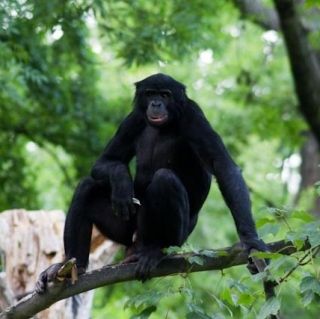Animal Behavior
Bonobos: The Peaceful Apes
Here's what we can learn from our dark, hairy cousins.
Posted November 24, 2023 Reviewed by Davia Sills
Key points
- There are remarkable differences between chimpanzees and bonobos.
- Chimpanzees and bonobos are both equally closely related to us.
- Chimpanzees, bonobos, and humans live in fission-fusion societies that split up into small subgroups.
- Bonobos may cooperate with unrelated individuals across groups—just like humans, but unlike any other species.
.jpg?itok=NafZs0lH)
When Jane Goodall went to Gombe in Tanzania in the 1960s to study wild chimpanzees, she made a number of discoveries that changed our picture of our closest living relatives. She discovered that chimpanzees produce tools, hunt monkeys, and form hierarchies that are dominated by males. She also recognized that they live in so-called fission-fusion societies. These are large groups consisting of 20 to 80 animals, which often split up into small subgroups (for example, to search for food) and then come together again. The subgroups vary in their composition so that each individual should know who is related to whom in order to form alliances and navigate conflicts.
But Jane Goodall also found that chimpanzees make war. They patrol the borders of their territory, brutally attacking other chimpanzees. Patrols from smaller groups try to avoid contact with their neighbors, whereas patrols from large groups will sometimes take over a smaller group’s territory. In other words, chimpanzees not only live in a similar group structure as humans—we also form groups of varying composition—but they are also as cruel as we are. Well, chimpanzees are our closest living relatives, so it made complete sense.

Some researchers have concluded that making war and being dominated by males is just in our genes. But chimpanzees are not our only closest living relatives—bonobos are equally close to us. This is possible because the common ancestor of chimpanzees and bonobos split from our lineage about 6 million years ago. Only later did the lineage of the chimpanzee-bonobo ancestor split into the two ape species we know today.
In other words—chimps and bonobos are brothers, and both are our cousins. For non-experts, they are not easy to distinguish: Bonobos have relatively long limbs, pinker lips, and a darker face than chimpanzees, and they keep their white tail-tufts through adulthood.
Bonobos are different
Because bonobos look so similar to chimpanzees, they were first distinguished as a separate species in 1928 in a Belgian museum. Moreover, they can be found only in one area—in what is today the Democratic Republic of Congo. This is the reason that the investigation of this species in the wild began quite late—more than a decade later than chimpanzees. But then came a big surprise: Bonobos have a matriarchal social structure.
Some researchers call bonobo societies “gender-balanced”—meaning that they have a sex-independent dominance hierarchy in which females often occupy the top ranks (Surbeck & Hohmann 2013). It also turns out that bonobos seem to live by the motto: “Make love, not war.” Sexual activity plays an important role in bonobo society. It is used to form social bonds as a means of conflict resolution and post-conflict reconciliation.
Bonobos also do not have a defined territory—and, thus, there is no obvious reason for severe violence and war. When primatologists sat together and compiled information from 18 chimpanzee communities and four bonobo communities studied over five decades, they found 152 killings in chimpanzees and just one killing in bonobos (Wilson et al. 2014). Even if bonobos are less studied than chimpanzees, this seems an obvious difference. These findings also mean that we are not pre-determined to make war. Our peaceful cousins are an example of that.
Cooperation outside the group
In a brand-new study, it was shown that bonobos are more similar to us than you would think. While humans are famous for being violent (just watch the news), we are also famous for being nice. We work together, we share food and money, and we have a sense of fairness. We sometimes even cooperate with others outside of our family, kin, and cultural groups.
A research team from Harvard and Göttingen investigated bonobos within their group but also when they met other groups (Samuni & Surbeck, 2023). They observed 95 encounters between the different groups. In contrast to chimpanzees, who would simply attack strangers (see above), bonobos groomed and shared food with members of other groups. The authors found that individuals who were very cooperative within their group were also likely to be particularly cooperative towards out-group individuals. Thus, bonobos are special. Just like humans—but unlike any other species—they cooperate with unrelated individuals across groups without immediate payoff.
Don’t get me wrong: Bonobos can also be violent. There is competition between the males that can lead to attacks with serious injuries. Females try to monopolize food sources—and they are often successful with the support of their allies. Thus, even with bonobos, it’s not all peace and joy. However, it seems to me that if we want to take our cue from someone, it’s better to take it from bonobos than chimpanzees.
References
Samuni, L., & Surbeck, M. (2023). Cooperation across social borders in bonobos. Science, 382(6672), 805-809.
Surbeck, M., & Hohmann, G. (2013). Intersexual dominance relationships and the influence of leverage on the outcome of conflicts in wild bonobos (Pan paniscus). Behavioral Ecology and Sociobiology, 67, 1767-1780.
Wilson, M. L., Boesch, C., Fruth, B., Furuichi, T., Gilby, I. C., Hashimoto, C., . . . Wrangham, R. W. (2014). Lethal aggression in Pan is better explained by adaptive strategies than human impacts. Nature, 513(7518), 414-417.


